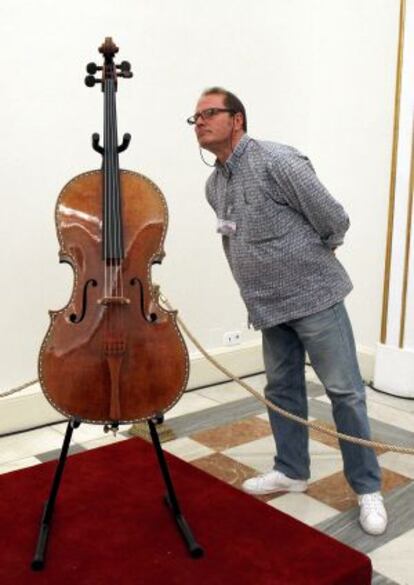Saving the soul of a Stradivarius
Spain unveils restored cello, which was dropped during a palace photo session

Mission accomplished. On Tuesday, Patrimonio Nacional - the body responsible for managing national heritage - presented a restored Stradivarius cello that broke in April during a photo session at the Royal Palace in Madrid.
The 17th-century instrument is part of the Spanish state's Stradivarius collection, considered the best in the world, and it is worth an estimated $25 to $30 million according to its restorer.
Carlos Racier, 70, a Colombian luthier with Calabrese ancestry who owns a restoration workshop in New York, spent three weeks in July working on the damaged cello, which fell sideways off the table while a palace curator was holding it up for a photo session. The fingerboard - the long mast-like piece - broke with an audible crack, leaving everyone in the room in a state of shock.
The broken piece, however, was not original, but itself a replacement put there in 1857.
The restored instrument appeared to be back in good shape on Tuesday, judging by the way it was played by master cellist Francisco González Espinosa, the president of the Spanish Association of Master Luthiers. A reduced audience of connoisseurs listened rapturously to a Bach suite filled with versatile sounds aimed at proving that the valuable cello is almost as good as new.
Made by Antonio Stradivari in his Cremona workshop in 1694, the cello was crafted with maple wood from Transylvania and has been used in scores of sublime music concerts ever since.
All the string instruments to come out of Stradivari's workshop - cellos, violins, lutes and more - continue to be considered the absolute best in the world, and are preserved like priceless treasures by museums and private collectors across the planet.
Fortunately, the part that broke off did not hit the belly, nor did it damage the sides of the cello, which are decorated with spiral shapes and mythological creatures made with Indian ink, as well as valuable mother-of-pearl inlaid work.
Weeks after the incident, the daily El Mundo broke the story, which created waves in European and American musical circles given the matchless singularity of the Spanish Stradivarius collection.
It was then that Patrimonio Nacional decided to restore it immediately, and officials began searching among the best craftsmen in the world for a suitable set of fingers.
The Royal Palace collection of string instruments is usually supervised by the French master luthier Etienne Batelet, who is in his nineties, but it was decided that the cello could not withstand the trip to France and should be repaired on site in Madrid.
The task finally fell to Carlos Racier, one in a long lineage of Italian woodworkers going back to the 18th century. Racier has looked after the collections of orchestras such as the New York Philharmonic, and opened Racier Violins in Manhattan 35 years ago, at 244 West 54th St.
The craftsman said that he made a new fingerboard out of Central European maple and placed it inside the original peg box. He added that he took special care to align the tangent of the scroll, which tops the instrument, with the line of the fingerboard on which he placed back the tuning fork, whose angle he changed slightly to make playing easier for future musicians. The restorer also admitted to changing the "soul," a wooden piece only 10mm thick that connects the top and bottom of the cello, but says he did so without opening up the instruments, instead inserting a long hook into the F-shaped holes.
The new piece was glued into place using animal-based collagens. "The harmonic bar has not been touched," the restorer added.
As for the price paid for the restoration, José Rodríguez Spiteri, president of Patrimonio Nacional, said it was "closer to the high four figures than to five figures."
Tu suscripción se está usando en otro dispositivo
¿Quieres añadir otro usuario a tu suscripción?
Si continúas leyendo en este dispositivo, no se podrá leer en el otro.
FlechaTu suscripción se está usando en otro dispositivo y solo puedes acceder a EL PAÍS desde un dispositivo a la vez.
Si quieres compartir tu cuenta, cambia tu suscripción a la modalidad Premium, así podrás añadir otro usuario. Cada uno accederá con su propia cuenta de email, lo que os permitirá personalizar vuestra experiencia en EL PAÍS.
¿Tienes una suscripción de empresa? Accede aquí para contratar más cuentas.
En el caso de no saber quién está usando tu cuenta, te recomendamos cambiar tu contraseña aquí.
Si decides continuar compartiendo tu cuenta, este mensaje se mostrará en tu dispositivo y en el de la otra persona que está usando tu cuenta de forma indefinida, afectando a tu experiencia de lectura. Puedes consultar aquí los términos y condiciones de la suscripción digital.
Últimas noticias
Reinhard Genzel, Nobel laureate in physics: ‘One-minute videos will never give you the truth’
Pinochet’s victims grapple with José Antonio Kast’s rise in Chile
From digital curfews to blocking apps: How technology experts protect their children online
Why the price of coffee has skyrocketed: from Brazilian plantations to specialty coffee houses
Most viewed
- Pablo Escobar’s hippos: A serious environmental problem, 40 years on
- Why we lost the habit of sleeping in two segments and how that changed our sense of time
- Trump’s obsession with putting his name on everything is unprecedented in the United States
- Charles Dubouloz, mountaineering star, retires at 36 with a farewell tour inspired by Walter Bonatti
- The Florida Keys tourist paradise is besieged by immigration agents: ‘We’ve never seen anything like this’








































